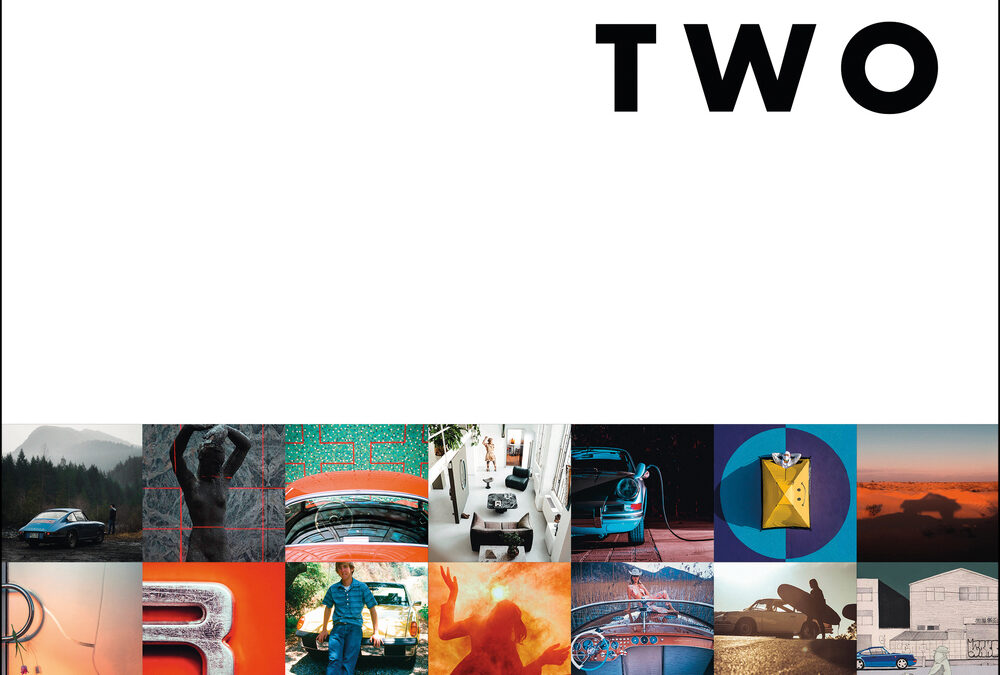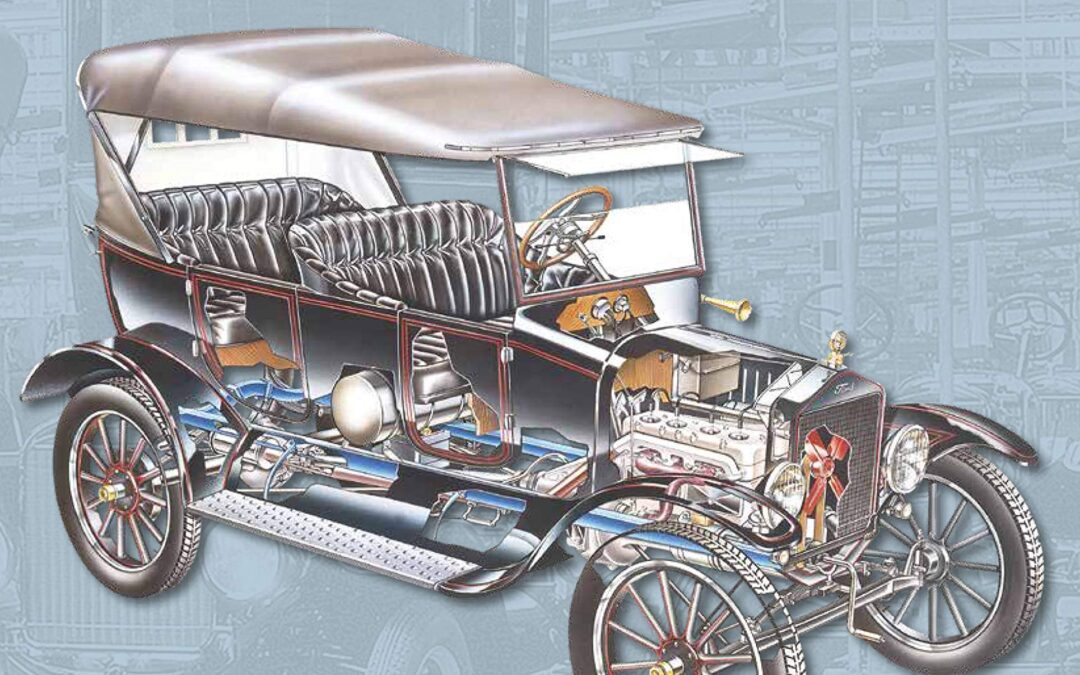
“I will build a car for the great multitude,” stated Henry Ford, and so he did.
The Ford Model T, or the ‘Tin Lizzie’ and the ‘Flivver’ as it was also known, transformed American society, bringing mobility through car ownership to millions of middle-class Americans at a time when the horse and the railroad were the only real viable means of transport.
Using moving assembly lines and the best possible materials, between October 1908 and May 1927, Ford built around 16.5 million examples of this extraordinary car. By 1918, half of all cars built in America were Model Ts and by 1925 around 8,000 a day were being produced, making Henry Ford one of the world’s best-known manufacturers of automobiles.
The selection of body styles varied from two- and four-seat open and closed models – tourers, town cars, runabouts, landaulettes and cabriolets – to vans and pick-up trucks, and customers could also have colours other than black!

Dialogue between one of the world�s most experienced racing car designers and a technical author-graduate engineer on the theory and technique of racing car design and development.
Contents include:
- The anatomy of a racing car designer
- Len Terry – A Biographical Sketch
- Description of nearly 30 Terry designs from clubman�s sports car to Indianapolis winner
- A blank sheet of paper – Len Terry explains his procedure for advancing a new design from the sketch pad to the race track
- Handling characteristics – The theoretical aspects; oversteer and understeer; practical implications
- Structural considerations – Space-frames and monocoques; the cockpit area; the structural engine; progress and legislation
- Suspension – Changing needs and layouts; the torsion bar; self-levelling systems; anti-dive and anti-squat; progressive-rate springing; stiffness/weight ratio
- Brakes, wheels and tires – Influence of smaller wheels; twin-disc brake systems; attention to details; low-profile tire phenomena
- Aerodynamics – Basic considerations; wings and things; intake ram effect; ‘ground effect’ vehicles
- The cooling system – Radiator location; cooling the oil
- Safety and comfort; primary and secondary safety; driver comfort
- Materials
- Components – Ball joints, batteries, brakes, clutches, dampers, driveshafts, electrics, flexible bearings, flexible fuel cells, gearshift linkages, instruments, non-return valves, nonspill fuel fillers, oil and fuel pipes, Perspex mouldings, radiators, springs and steering gear; design versus development
- The competition – nine other racing car designers discussed
- Future developments

Extraordinary engineering; extraordinary places: Discovering Engineering that Changed the World takes you on a fascinating journey to visit marvelous engineering and technological achievements around the world.
- From deep underground in an Arizona missile silo, to being in the pilot’s seat of one of the biggest hovercraft that has ever flown.
- See the world’s fastest helicopter, aircraft and steam train.
- Deep inside the mighty Hoover Dam – one of the most incredible structures ever built – to walking the ground where the Wright Brothers first flew.
- From marveling at the jet road cars built by Rover and Chrysler, to seeing Land Speed Record cars like Bluebird and Thrust SSC.
- Fascinating sights – the suspension bridge that carried all the materials for the first atomic bomb.
- The world’s first turbo production car engine.
- The luxury lounge of the Hindenburg airship.
- The first streamlined, stainless-steel diesel train.
Passionate and insightful, this is an incredible adventure through the best things the world has to offer for anyone who likes speed, technology and excitement. The result of Julian Edgar’s own journey around the world, seeking out the most exciting engineering and technological sights he could find, you may well want to use this book to plan your own trip.

Lifestyle journalist Thijs Demeulemeester takes you on a trip through some iconic houses and the unique cars that match them in elegance of design and construction.
“Life is too short to drive boring cars.” – Hanan Sobati, founder of Arabian Gazelles, the first female supercar club in the world.
“I only purchase and drive cars that represent thoughtful design, elegance and performance.” – Frank Lloyd Wright
This book about beautifully designed cars and international architecture has been curated with an eye for pure aesthetics. Although architecture and cars are theoretically miles apart, the sources of inspiration for their designers are often strikingly similar. Recalling a time when you could recognize an architect from his Saab or his Citroën DS, lifestyle journalist Thijs Demeulemeester shows that architects and luxury car makers are alike in their appreciation of elegance of design, attention to materials, and solid construction. This book takes you on a trip through some iconic houses and the unique cars that match them.
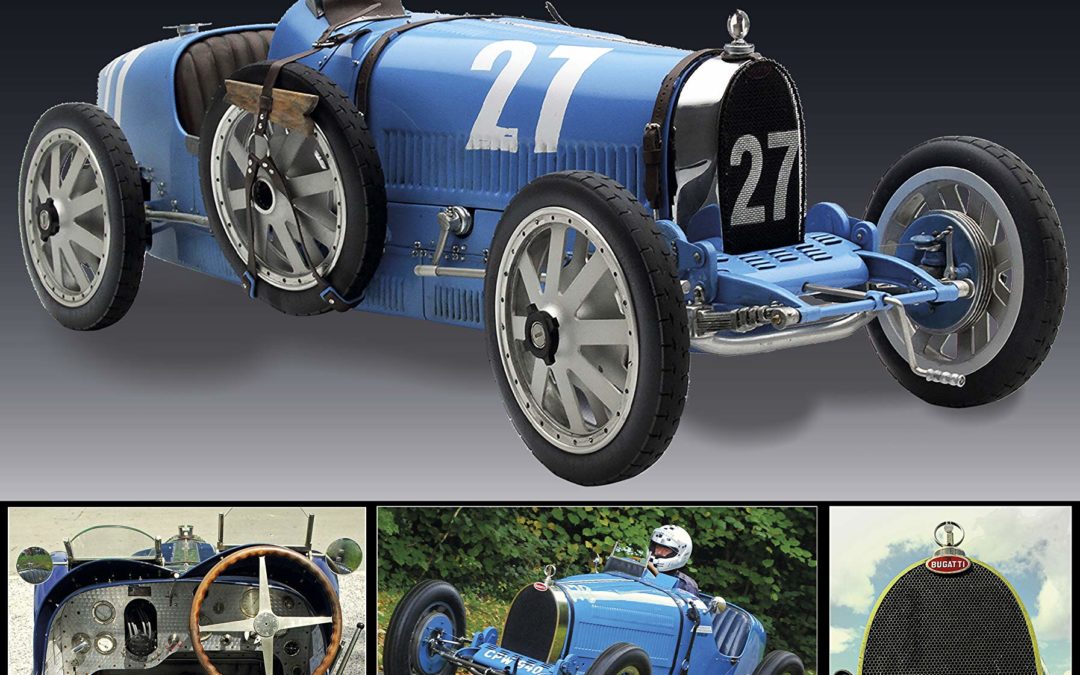
This new book, the first in the CarCraft series delivers an innovative presentation to the car enthusiast by covering the engineering, design, and modeling of one of motoring’s greatest cars across all its epochs.
Ettore Bugatti changed engineering history with his genius and innovations. With its clever engine design, new suspension thinking, and distinct body style, Bugatti’s T35 and its variants defined a new era of design and driving and must surely rank as true ‘supercars’. A motor sport legend was also cast down by these Bugattis.
Experienced automotive writer, industrial designer and Bugatti Owners Club member Lance Cole pays tribute to the car in a detailed yet engaging commentary. New photography, the design story, and full coverage of the modeling options in synthetic materials and die cast metals, create a narrative of vital interest.
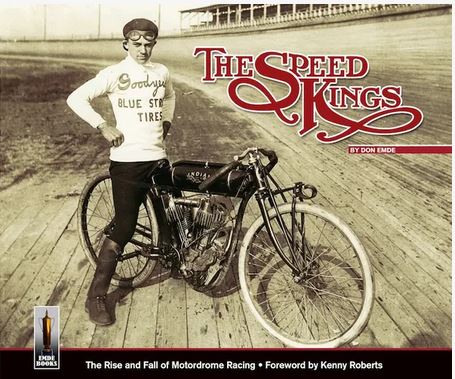
Don Emde presents the birth, evolution and eventual demise of motordrome racing with amazing illustrations and rare historical materials. The Speed Kings: The Rise and Fall of Motordrome Racing, by Don Emde includes 600 illustrations and 40 chapters over 372 pages. Four-color sepia tone throughout, and printed right here in the United States of America! Foreword by Kenny Roberts

Initially published in 1954 and revised in 1962, Metals and How to Weld Them is a standard reference in the field and provides the foundation of modern welding methods. This practical guide provides everything you need to get started welding, including information on preheating, heat treating, mechanical properties of metals, filler material selection, crystallography, and welding process options.
In addition to the basics, Jefferson and Woods address an array of technical and chemical principals at work within the internal structure of metals and how these structures relate to mechanical and physical properties in addition to weldability. An assortment of diagrams, photos, and charts depict key ideas such as the characteristics of metals, how different metals change during the welding process, physical chemistry of steel alloys, fundamentals of metallurgy, and more.
Jefferson and Wood’s guidance will give you confidence in determining what welding materials and methods are right for the job. Metals and How to Weld Them has a place in the library of every amateur welder.

Metalshaping – Volumes 1 & 2 The secrets of shaping sheet metal are revealed, from the first car to current day and beyond. A four-year effort with over 500 contributors from around the world. Research includes the first patents, the first ads, and a breakdown of machinery models. Mind-blowing introduction to suppressed technology and to future-tech. Loads of photo instruction with full contact lists.
Book #1 Two chapters reveal the full history of automatic power hammers with original materials not seen in years. Two chapters show step-by-step body-making instructions in photos. One chapter covers “All about Louvers” and shows making louvers in detail. New discoveries in metal resurfacing are detailed in depth. Included is a history of why the technology was suppressed. One chapter shows inner and outer work on a Coach- built Ferrari.

The postwar Morris Minor, designed by Alec Issigonis, was one of the most popular British Cars. 2018 marks 70 years since the first Minors rolled off the production lines at Cowley in Oxfordshire. In this celebratory publication Ray Newell looks in detail at the development of the wide range of models produced during a production run that spanned twenty two years in the UK. Using mainly contemporary materials covering four decades, he transports the reader back to an era when the pace of life was much slower and the marketing of the vehicles was considerably different to the slick advertising of today. The worldwide appeal of this trend-setting vehicle is examined in the context of the ‘export or die’ mentality that dominated postwar Britain, as are the innovative production methods used to ensure that ‘Morris Motors Ltd’ lived up to its ‘quality first’ reputation. Variations from standard specifications are considered with reference to mechanical uprating, different body styles and the use of modern accessories to enhance further the comfort and styling of what was dubbed ‘The World’s Supreme Small Car’. Issigonis sketches of the prototype cars, sales brochures, promotional materials, and rare and unusual photographs make this a fascinating book. The continuing appeal of the car voted Britain’s most popular classic in 2016 is examined, as are the factors which continue to attract a new generation of 21st century owners.
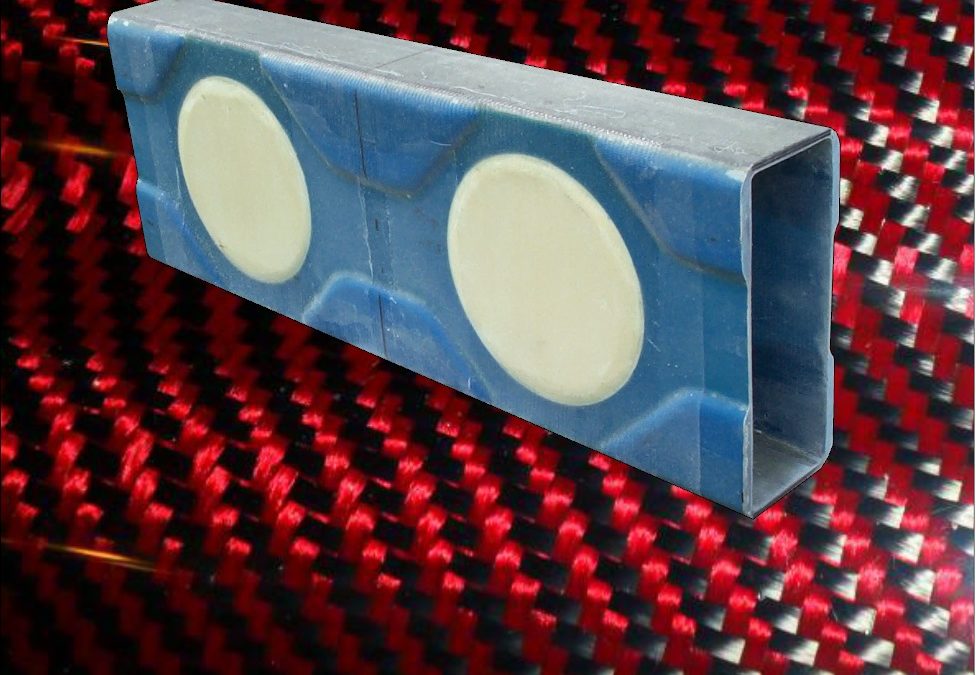
Composite Structures & Construction: Modern methods for Wet-Layup and Prepreg Construction for Aerospace, Automotive & Marine Applications
This book has a broad range from Beginners to Seasoned Composite Designers & Fabricators.
Composite Construction can be an Ideal Fabrication method for:
- Aircraft
- Cars
- Motorcycles
- Boats
Work with a construction medium that will do want you want it to with out an up-hill battle to gain every inch.
Easily Achieve Complex Structures with minimal Tooling & Facilities.
In this book you will learn about:
- Shop Safety
- Tools
- Raw materials: (Fiberglass, Carbon, Cores, Films, Fillers, Inserts)
- Jigs / Fixtures & Molds
- Wet Layup & Prepreg
- Kitting & Flat Patterns
- Bonding & Joining
- Finishing
Order this Book Today & Get Started on your Journey

NEW EDITION
Automobiles capture the imagination as much as ever, and now is your chance to learn to design your own! Using simple, step-by-step instructions, this book guides you from pencil sketch to marker rendering; from doodle to computer generated artwork.
Adrian Dewey has worked on designs as diverse as small sports cars to double decker buses, modified motors to concept Formula 1 cars, and is an expert in a variety techniques and styles of design. In this book, he uses his knowledge of the different styles to guide the reader in creating great artwork and designs of their own.
You will learn in detail how to use different materials, and how to get the most out of each one, whether it be a pencil sketch or a photo realistic vector illustration.
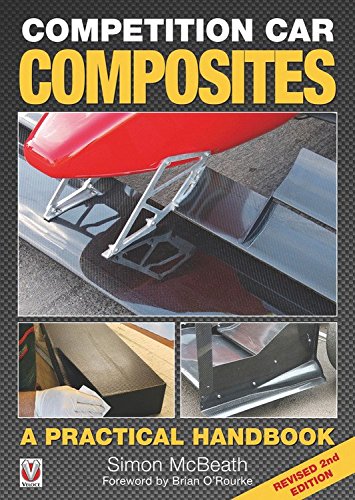
Composites have been around since ancient civilisations began making bricks from clay and straw. Glass fibre, carbon fibre and aramid fibres – to name but three – are recent innovations, yet today there are few competition cars that don’t have at least some components made out of one or more of these materials. However, while it is well known that glass fibre technology can be used in the home workshop, what may not be so widely realised is that more advanced fibres also lend themselves to DIY methods.
This revised edition of Competition Car Composites starts by examining the materials and methods that can be used, explaining basic ‘wet’ and ‘dry’ laminating techniques, pattern making and mould construction, and the design and manufacture of components. It then goes on to cover material and technology upgrades, and how more advanced materials can be exploited to achieve improved properties and reduced weight. The use of thermoplastic materials, resin infusion methods, and, especially, ‘pre-pregs’ in the home workshop, are also discussed, as are the composite techniques used by top racecar constructors.

The needs of a true competition engine are quite different than those of the engine under the hood of a typical commuter car. From the basic design needs, to the base component materials, to the sizes of the flow-related hardware, to the precision of the machining, to the capabilities of each pertinent system, very few similarities exist. Many books exist showcasing how to make street-based engines more powerful and/or durable. This book is different, in that it focuses purely on the needs of high rpm, high durability, high-powered racing engines. It begins by looking at the raw design needs, and then shares how these needs are met at the various phases of an engine’s development, assembly, testing and tuning.
This book features reviews of many popular modern tools, techniques, products, and testing/data collecting machinery. Showing the proper way to use such tools, how to accurately collect data, and how to use the data effectively when designing an engine, is critical information not readily available elsewhere. The special needs of a competition engine aren’t commonly discussed, and the many secrets competition engine builders hold closely are openly shared on the pages here.
Authored by veteran author John Baechtel, Competition Engine Building stands alone as a premier guide for enthusiasts and students of the racing engine. It also serves as a reference guide for experienced professionals anxious to learn the latest techniques or see how the newest tools are used. Baechtel is more than just an author, as he holds (or has held) several World Records at Bonneville. Additionally, his engines have won countless races in many disciplines, including road racing and drag racing.
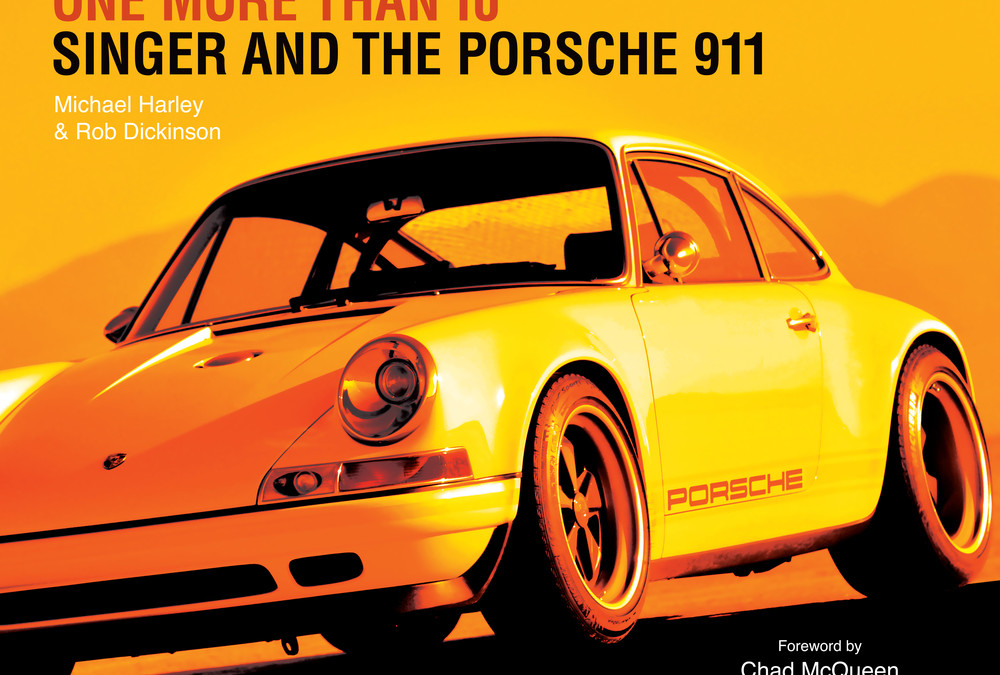
LIMITED EDITION RE-PRINT
Some call them the best air-cooled Porsches ever, others the best cars in the world. They are the Porsche 911 sports cars that have been restored, re-imagined, and reborn by Singer Vehicle Design.
Each commission represents a unique collaboration between the customer and Singer, combining bespoke carbon fiber body panels, the finest in optimized mechanical and electrical components, superlative materials and finishes, and the spirit of the golden age of the iconic air-cooled 911. Every Singer-restored car is an incomparable work of impeccable craftsmanship. One More than 10: Singer and the Porsche 911 brings the reader as close to these beautiful machines as one can get, excepting the lucky few who own one.
Singer Vehicle Design is driven by the singular vision of Rob Dickinson, an ex-car designer and rock musician who came to be one of the world’s foremost distillers of the essence of air-cooled Porsche. Journalist Michael Harley and Dickinson tell the story, while an all-star cast of automotive writers, journalists, and personalities offer their perspectives on the Singer phenomenon. Throughout the book some of the finest photographers in the automotive world, with unparalleled access to Singer’s operations, reveal the sublime beauty of these Porsche 911s as they are restored, and as they play at the track and run the open road. More than that, the book tells the story of how a life-long obsession with the most important sports car on the planet, which began on an autoroute in France in the ’70s, came to find a home on the concours lawns and racetracks of the world’s most prestigious automotive events.

A guide to fiber reinforced plastic materials, including fiberglass, Kevlar, and carbon fiber. It also includes sections on mold making, plugs, materials, structures, gel coats, advanced building techniques, tools and equipment.

“Antique Auto Body Leather Work for the Restorer,” by Herbert J. Butler. Find out how to restore or recreate your early auto interior. This guide reproduces period sources that show you how reupholster seats, doors, headliners, and interior trim. You will learn about the materials & tools used in the art and craft of motor trimming: motor hides, Morocco leather, imitation leather, combined leather and lining material, cloth, canvas, carpets, coach laces, stuffing materials, cushion springs, trimmers’ tools, and tufting machines. Find out the specifics of making seat cushions: the amount of fullness, the cushion pad, making the cushion borders, cushion with wood frame foundations, cushion without borders, plain trimming, the front roll, backs, side quarters, side and backs in one. You will also learn about other interior upholstery: door trimming, doors of closed bodies, front lining boards, headlining leathers, and metal beading. You can use the scaled layouts (with descriptions and instructions) for typical body types to recreate authentic leather trim for your restoration: limousine in hand-buffed leather, coach, depot wagon, landaulet, Electric Opera Bus, Brougham, Full Leather Phaeton, Limousine in Bedford Cord, Electric Brougham, the High-Wheeler, Limousine in Cloth, Runabout Roadster, and the Electric Stanhope Phaeton. You will also learn about cutting curtains, filling cushions, spring construction, and ventilating cushions. This book faithfully reproduces trim data originally appearing between 1905 and 1908 in rare American trade publications, together with relevant British material from 1924. Includes introductory text from “Motor Body Work” by Herbert J. Butler. The publisher states that “for mastery, this practically lost art requires no more than common sense, coupled with qualified instruction. 127 pages, softbound. Year Application – General.

“Antique Auto Body Wood Work for the Restorer” by C.W. Terry with Arthur Hall. This book is largely drawn from “Motor Body Building,” which was published in London and New York in 1914 – the top text in the field, written by Britain’s best experts. You will find details of the principles of design from that era, rules of thumb for proportions of particular body types, and specifications for the wood & metal typically used on bodies. Learn about principles of putting together bodies in that era, such as the selection of timber, ways of chassis framing, design for weight & accommodation, constructing the framework, kinds of joints used in framing, strength and stiffness of materials, stress & strain, panel work, iron work, mounting (to allow for movement), doors & pillars, mudguards, methods for making corners in wood, and much more. The authors give detailed instructions for creating design drawings from the side elevation, cant board (side seen from top), the chassis line, sweeps, proportion in seating, and what makes a good design. Includes illustrations, diagrams, drawing, design and construction of body types, including: Limousine, Limo with quarter windows, limo with fishtail back, limo with round quarters, Cabriolet, Convertible two-seater, Touring (Torpedo), Landaulet, Landaulet with quarter windows, flush side body, and detachable Tonneau (convertible 2-4). 127 pages, softbound . Own this hard-to-find information on a golden age of automobiles.

Current state of the art in racing technology by a foremost expert in the field. Covers all forms of racing cars and includes a thorough analysis of metallurgy, metal fatigue and general materials technology. Details specific components and specific activities such as heat treatments, stress relieving, etc. Plus aerodynamics, ground effects, brakes, tools, and more.

How to identify and verify V-8 drivetrain parts for small and big blocks on Chevrolet passenger cars from 1955-1959, including:
- Series 150
- Bel Air
- Corvette
|
- Series 210
- El Camino
- Impala
|
Based extensively upon original source materials from Chevrolet Archives
| Chevrolet by the Numbers is the only authoritative reference for identifying and verifying the correct Chevrolet parts, by casting number, for your exact model. |



